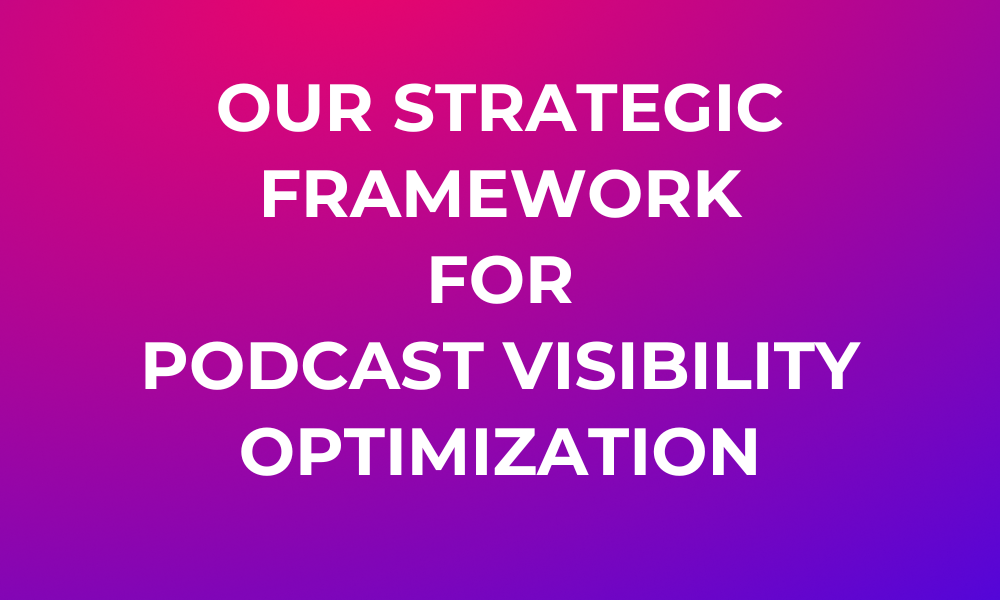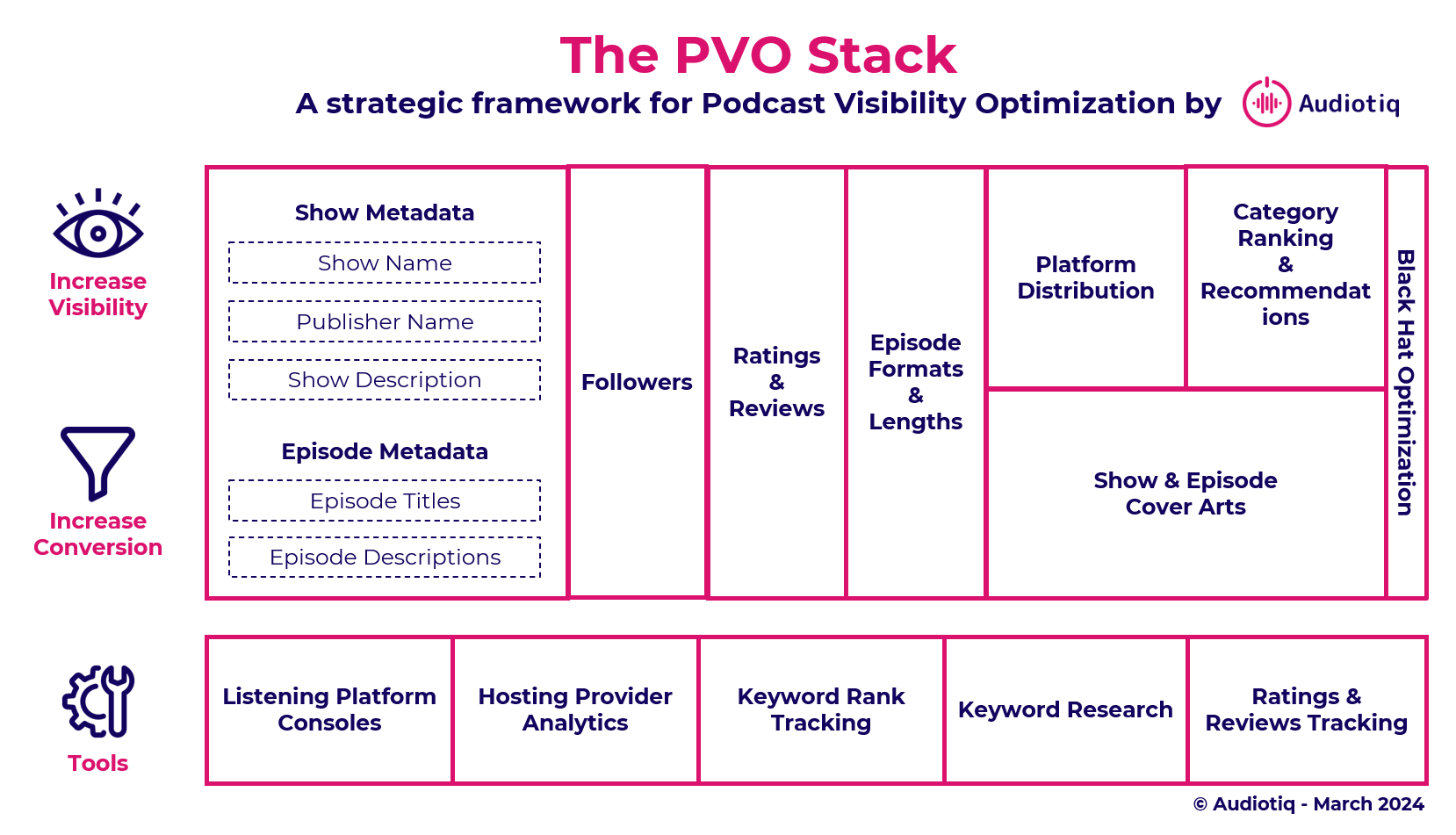
The Podcast Visibility Optimization Stack is a cheat sheet for podcast producers and marketers who want to understand better the levers they can pull to improve the visibility of their audio content on podcast platforms (Apple Podcasts, Spotify, Amazon Music, etc.).
PVO (Podcast Visibility Optimization) has plenty of similarities with both SEO (Search Engine Optimization) and ASO (App Store Optimization) but is a different science due to the sheer nature of podcasting and the listening platforms.
By simplifying PVO to “SEO for podcasts,” the danger is to focus mostly on keyword optimization. Leading podcast marketers have realized that the conversion rate (from seeing the details of your podcast to clicking/tapping the icon to start listening) is just as important.
When considering PVO holistically, one needs to consider it a complex and interconnected system of elements that influence its two main goals: increasing visibility and conversion.
For example, ratings and reviews impact a show’s visibility on a given search query and the conversion from “seeing” to “clicking”.
This article details the various elements of the Podcast Visibility Optimization Stack and shares examples of tactics to leverage.
Let’s dive in.

Before jumping to the various elements to optimize, let’s quickly summarize how the listening platforms’ search algorithms work.
To make it overly simple, the platforms rely on two elements to rank your show on a given search query:
- The Podcast Metadata
- The Podcast Authority
Podcast Metadata is the data that describes your show. Not the content of your episodes, but how you describe them.
Podcast Authority is an index – proprietary to each platform – that evaluates the authority or strength of a podcast. The various elements the platforms are taking into account are:
- Number of subscribers
- Number of downloads/listens
- Reviews & Ratings
- Completion rate
- Binge listening
- Velocity
- Freshness of content
- etc.
Now, let’s review the practical details and see how to optimize the visibility of your audio content.
1. Show and Episode Assets
Impact on increasing visibility: high
Impact on increasing conversion: medium
The number one way for podcast listeners to discover new content is by going straight to the search bar of their listening app. This is a behavior inherited from the web and mobile worlds, where approximately half the websites or mobile apps are discovered via a search query. Listeners could be searching for generic keywords (“news”, “football”, “meditation”), sometimes with typos (“nwes”, “fotabll”, “meditaiton”) or branded ones (“New York Times”, “Joe Rogan”).
Podcast producers need to remember that search is at the bottom of the conversion funnel: users want something and know what they are looking for.
The goal with PVO is ultimately to attract new listeners that will then be retained. One of podcast publishers’ main levers and a massively untackled opportunity is keyword optimization.
By optimizing their position on the right keywords, publishers can rank high or keywords relevant to their content. They can ensure that people looking for that kind of content see their show or specific episodes.
Therefore, the goal is for a podcast to rank as high as possible on keywords with high search volume that are relevant to the podcast. High search volume means that the topic is highly searched by potential listeners. In other words, there is demand for it.
Podcast publishers also need to consider the difficulty of the keywords they decide to optimize. A good example here is news. It will require a tremendous effort and massive podcast authority for a show to outrank The Daily on the search query “news”.
While a search query on the web interface of Google shows 10 results on its first page, podcast apps tend to show less, and Spotify even mixes podcasts with playlists. Therefore producers should focus on getting their content ranked in the top 3 to 5 positions. To achieve this, the process is:
- Identify the high-volume, relevant keywords and search terms that users would type in their apps’ search bar. Ideally, also identify those with a low level of competition.
- Integrate those keywords in the podcast’s assets: show name, artist name, short and long descriptions, episode title, and episode description. The presence of a given keyword in those different places doesn’t have the same weight. A keyword in the show title obviously has more weight than in the episode description.
- Analyze the impact of the changes and iterate. Keyword optimization is a continuous process. To continuously rank high on important keywords, publishers need to keep optimizing as search trends and the ranking algorithms of Apple, Spotify, and other platforms evolve. Not to mention that competition may also be trying to get that first spot on those lucrative keywords.
Our training sessions and workshops cover extensively how to pick the right keywords and the optimization process.
2. Podcast Followers and Subscribers
Impact on increasing visibility: high
Impact on increasing conversion: low (indirect)
The latest Apple Podcasts and Spotify search algorithm updates increased the importance of the follower (or subscribers) count. A high follower count indicates that a show interests listeners, so they don’t want to miss an episode release. That interest reinforces a podcast’s authority, pushing it up the ranking for the keywords used in its assets.
It also has an indirect and low impact on conversion as it generates extra – automated – downloads for every new episode published, depending on the subscription settings of the subscriber.
3. Ratings and Reviews
Impact on increasing visibility: high
Impact on increasing conversion: medium
In addition to increasing visibility, the number of reviews and average ratings significantly impact conversion. Apple Podcasts, like most platforms, lets users rate podcasts from 1 to 5 stars. However, the process of leaving a review is cumbersome, and not many users will go that far. Therefore, it is another strong authority signal sent to the platforms.
Positive ratings and great reviews are part of a virtuous circle: the more positive ratings you get, the more visibility our podcast gets, the more conversion, and ultimately the more users….who then generate more positive ratings.
Several studies in the mobile ecosystem have shown the importance of ratings, and so far, there is no reason to believe that this is different for podcasts. Below is one from Apptentive (now Alchemer), where the numbers speak for themselves.

4. Episode Formats and Lengths
Impact on increasing visibility: medium
Impact on increasing conversion: medium
The length of a podcast has a psychological impact on users. Those who discovered your podcast after a search query and have a 20-minute window to listen may not be ready yet to listen to a 60-minute episode.
Even if users could drop out at any time, it feels like a long commitment, especially at a time when attention spans are constantly decreasing.
So when producing and editing an episode, publishers should consider options such as 1×60 minutes, 2×30 minutes, 3×20 minutes, 4×15 minutes, the full (long version) next to a “best of” or “summary” version…etc. This will impact the conversion rate.
This is what we call the “salami tactic”: taking one piece of content and slicing it into as many slices as possible. Someone wanting a short version will find what she wants; the same goes for someone wanting an extended version.
Some radio stations are increasingly using this tactic, as it allows them to top the chart (“the most downloaded sports podcast in France,” for example) and gain the attention of the advertisers as subscribers often have shows on auto downloads.
More downloads mean more ads sold. Now, let’s be honest: Most of those downloads will not be listened to, but that’s a different topic.

5. Platform Distribution
Impact on increasing visibility: medium
Impact on increasing conversion: none
Imagine a customer walking into a grocery store and looking for something to drink: she will pick whatever is available on the shelves. The same applies to podcasts: to be heard your content needs to be in the listeners’ favorite listening platforms.
Today – excluding some specific exclusives – most shows are on Apple Podcasts and Spotify. But what about Amazon Music, Deezer, Pocket Casts, Gaana, Podeo,…etc?
And let’s not forget YouTube, which now also ingests RSS feeds and seems to be growing in popularity with younger audiences listening (!) to podcasts.
6. Category Ranking and Recommendations
Impact on increasing visibility: high
Impact on increasing conversion: none
Potential listeners are not only searching for content; they may also be browsing the platforms and various categories, checking the latest hottest thing, or simply letting the platform recommend what to listen to next. So having a strategy to be either visible in the relevant categories or be recommended is important to grow an audience.
There are plenty of tips and tricks for reaching the top of the Apple Podcasts categories with a small budget. If that interests you, reach out—we help plenty of publishers with this.
The importance of the Spotify Recommender has significantly increased in recent years. And to no one’s surprise, the data Spotify uses to recommend are quality content, metadata, authority and the Host Recommendation feature.
If you want to explore the topic further, we have a complete article on how to boost your visibility with Spotify Recommender.
7. Show and episodes cover arts
Impact on increasing visibility: none
Impact on increasing conversion: high
As the saying goes, “Never judge a book by its cover.” Unfortunately, that doesn’t apply to podcasts. When searching for content around a given topic, potential listeners will be presented with a list of shows, and the cover art occupies the most space on the screen. Listeners will often decide which one to click/tap simply by judging the cover art.
It is, therefore, paramount to optimize podcast cover art. Art is always a question of perception and taste, and we know too well that there are sometimes imperatives, such as showing the face of the anchorman/woman on the cover (even if most won’t recognize him/her), but we recommend to at least:
- Think mobile first (ie small screens)
- Have your cover art easy to read and grasp in a split second
- Test if before launching
The section on the cover art is often one of the most discussed and debated in our training sessions. Data has proven that optimizing a cover art could increase your conversion (from “seeing” to “clicking and listening”) by more than 10%.
8. Black Hat Optimization
Impact on increasing visibility: it depends
Impact on increasing conversion: it depends
Black hat Podcast Visibility Optimization (PVO), just like black hat SEO – a practice against search engine guidelines used to get a site ranking higher in search results could deliver substantial results in terms of visibility and conversion.
The challenge is that the platforms have different guidelines that are kept necessarily vague as the technology and ecosystem evolve. It is, therefore, not always easy to know when you are crossing the line.
What is clearly within the guidelines is named white hat, what is clearly against black hat, and the big blurry space in between grey hat. Some of the tactics we are aware of in the podcast world are and our classification of it
- Incentivized or paid reviews & ratings – black
- Own reviews & ratings – light grey
- Negative reviews on competition – dark grey
- “Burst campaigns” –light grey to grey
- Bot download or streaming – black
- Incentivized downloads/search – grey
- Keyword stuffing – grey
- Using fake brand names – black

To sum it up
As detailed above, there are plenty of levers to pull when it comes to Podcast Visibility Optimization Plenty. None of them is extremely demanding, but a coordinated approach is necessary to maximize the impact of PVO efforts and reach higher rankings.
We have trained many teams at organizations such as the BBC, The Guardian, The Telegraph, RTBF, RTL, and Europe 1 on Podcast Visibility Optimization and are supporting them in their ongoing efforts.
If you think you need help maximizing the visibility of your content within the listening platforms, get in touch: we will be happy to help!
